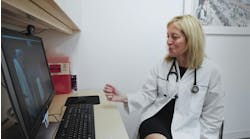On October 12, at the Houston Marriott Medical Center, the Healthcare Innovation Texas Summit kicked off with a keynote presentation by Michelle Stansbury, vice president, innovation and IT applications, at the eight-hospital Houston Methodist, who spoke on the topic “Shaping the Future of Healthcare Innovation.”
Innovation really is now embedded in everything that she and her colleagues are doing at Houston Methodist, Stansbury told the audience. Indeed, she noted, “Our chief innovation officer is also CEO of our flagship hospital” (Houston Methodist Hospital). “That’s on purpose, in order to quickly roll out innovations enterprise-wide. We’re very focused on transforming our organization, and we have three overarching goals, she said. “One is creating a seamless journey for our patients. Second, how are we making clinicians’ jobs easier? That’s a huge goal And the third is creating efficiencies in our organization.”
Stansbury noted to the audience that she and her colleagues continue to make progress in developing the new pavilion scheduled to open in 2025, which she and her colleagues are calling “our smart hospital of the future.” One very interesting aspect of the development of the new pavilion, she notes, is that “We’re not waiting to utilize the technology that we’re going to be putting in the new hospital; we’re already using it today. We also want our staff to understand the process changes that will take place in implementing the technology. And in our ambulatory space, we’re already focusing on building the smart ambulatory care of the future.”
Among the several key elements that she and her colleagues are focusing on, Stansbury went on to say, is folding into the development of the new facility a panoply of technologies and strategies to create for patients a “digitally engaged experience, inpatient and outpatient, and looking at that entire journey. What does the visit look like when patients are there?” she said, pointing to outpatient as well as inpatient encounters. “Do they know what their financial responsibility is? And if you’re not making sure they’re getting a follow-up appointment with you, it will be with somebody else.” In that context, she and her colleagues have been looking at the levels available to patients of system access across all access points, from virtual to referral management, to call center use. “While we’d love to get rid of call centers, it won’t happen,” she said. “We have to make them better.”
One area that Stansbury pointed out was around transforming how her organization’s leaders strategize around and manage, patient flow, bed capacity, and clinician workflow. “If you’re not looking at your overall capacity for patient care delivery, you’re not doing it right,” she said, and provided some details around how she and her colleagues have already made strides in that area.
They’re also diving into artificial intelligence, finding uses for AI tools. One has been around prescription refills, using voice-bot technology, and also, extending voice-bot technology to support patient self-scheduling for outpatient visits, which has been satisfying to patients and eased pressures on staff. That, she said, has been “a quick win.”
Further, Stansbury told her audience, “We’ve been very focused on virtual health. Creating our virtual operations command center was foundational for us, and it started with a virtual ICU. We created the virtual command center to be able to manage all our ICUs; it’s been awesome. Right before COVID, we had a two- or three-year project planned to launch our virtual ICU program, but within six months, we were able to get virtual care management across our entire organization.”
Further, Stansbury said, “We’ve already activated one major element of virtual care in the context of telenursing. We’ve put iPads in every patient room of our hospitals so that patients could talk with family members, and so that we could do virtual consults as well.” In addition, nurses in the virtual command center now prepare the discharge letter process for patients being prepared for discharge, a change that has freed up a great deal of time for nurses; she and her colleagues had investigated the situation and found that it was taking nurses 45 minutes just to prepare a discharge letter, a huge time burden on their days. Now, she said, it takes 12-15 minutes to process admissions and discharges. “The floor nurses love it, the nurses in the command center love it, the patients love it. It’s been a game-changer for us having a virtual command center.”
Further, Stansbury and her colleagues are working on leveraging the technology available to patients in their inpatient rooms, by utilizing camera technology connected to television sets, to support virtual nursing. The plan is to really create true smart patient rooms, allowing for a number of advances, including virtual clinical rounding, family education, and the virtual participation of family members in discharges. One stumbling block to overcome: a huge diversity of the sizes, types, and brands of television sets across the health system; the television sets have to be high-grade to be useful clinically, she noted.
Per smart rooms, she added, “We’re looking at using monitors to monitor potential falls in patients. We are piloting this technology. We still have people working in our virtual command center doing the monitoring.
Another area of advance: “We’ve got cameras in the ORs to learn how long it takes to set up cases, to operate, to clean them up. We’re learning a tremendous amount from analyzing the data from that; data is power.”
Meanwhile, Stansbury noted that she and her colleagues are beginning to strategize around the concept of a hospital-at-home program; she told the audience that the program would be managed through the virtual command center. That combination—a virtual command center connected to a hospital-at-home program—would be a first in the nation, she confirmed, in response to an audience question.



